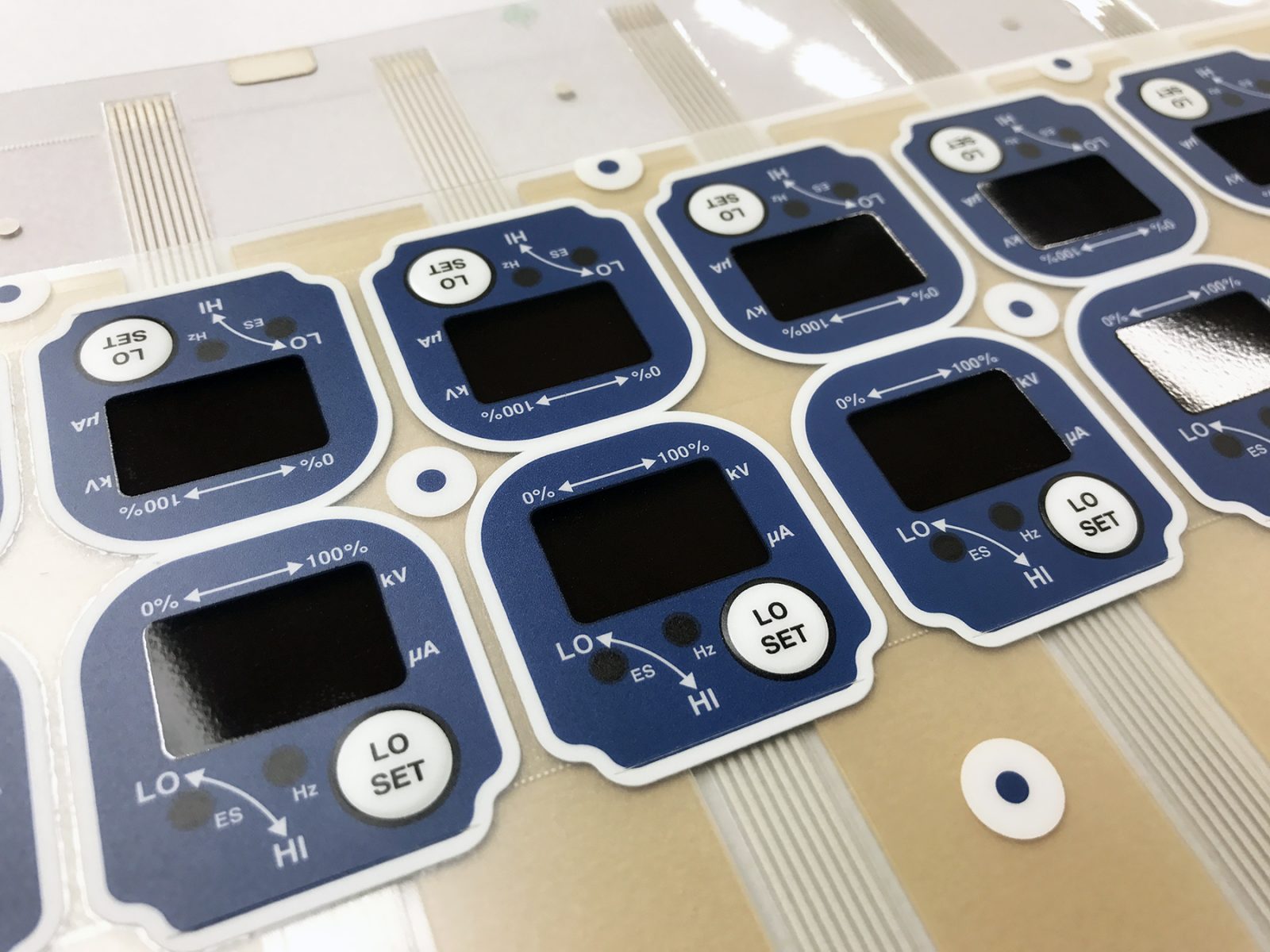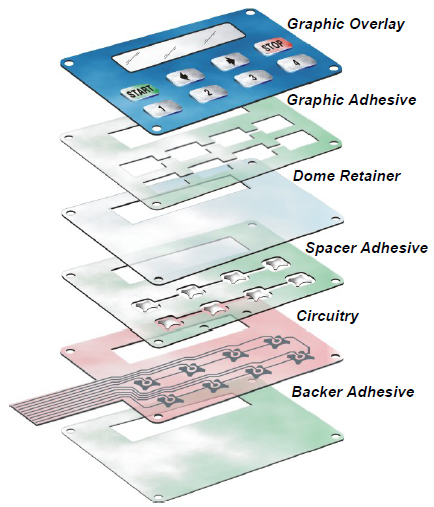Choosing a reliable membrane switch manufacturer is crucial for efficient electronic interfaces.
Choosing a reliable membrane switch manufacturer is crucial for efficient electronic interfaces.
Blog Article
What to Look for When Selecting a Membrane Switch for Your Task
When you're choosing a membrane button for your job, several vital elements come into play. You'll need to assume regarding the materials, layout, and how well it lines up with your brand.
Understanding Membrane Switch Parts
When you plunge into the world of membrane buttons, it's important to understand the vital components that make them function. The button typically includes three major layers: the visuals overlay, the spacer layer, and the circuit layer. The graphic overlay provides the aesthetic interface, showing switches and signs you require for very easy navigating. Under that, the spacer layer assurances there suffices range between the circuit and the overlay, enabling the button to trigger without continuous stress.
Comprehending exactly how these layers function together helps you choose a membrane layer button that's reputable and fits your job requirements. Pay close interest to the density and material of each layer, as these aspects affect longevity and capability in numerous environments.
Material Choice and Its Influence
Picking the ideal products for your membrane layer button can significantly affect its efficiency and longevity. The choice of substratum, typically polyester or polycarbonate, affects resilience and versatility. Polyester is extra abrasion-resistant, while polycarbonate offers better quality and strength.
Next, take into consideration the adhesive. It requires to withstand environmental aspects like wetness and temperature level adjustments. A strong adhesive warranties that your membrane layer button remains undamaged gradually.
Do not ignore the graphic overlay. The printing approach utilized, whether silkscreen or digital, affects the button's appearances and longevity. Top quality inks will withstand fading and scraping, maintaining a professional look.
Finally, consider ecological conditions. If your tool will be exposed to harsh chemicals or severe temperature levels, choose products made to withstand these obstacles. Your selections in materials will inevitably establish the switch's reliability and individual contentment.
Style Considerations for User Experience
Selecting the ideal materials lays the structure for a successful membrane switch, yet the design additionally plays a substantial role in customer experience. You'll desire to review exactly how the format influences functionality (membrane switch manufacturer). Keep switches and icons instinctive and well-spaced, making it very easy for individuals to navigate without confusion

Shade and comparison are also essential; warranty that your design is visually enticing yet still functional. High comparison assists customers conveniently determine switches, especially in low-light conditions.
Lastly, assess the total visual. A sleek and modern-day style can boost customer understanding and make your item more attractive. Balancing performance with an interesting design will result in a much better individual experience and inevitably, a more successful item.

Environmental Factors and Sturdiness
When choosing a membrane switch, you require to take right into account just how it'll execute in various atmospheres. Factors like temperature resistance, dampness and chemical exposure, and mechanical wear can greatly affect its sturdiness. Comprehending these components will help you select a switch that withstands your specific problems.
Temperature Level Resistance Requirements
As ecological problems can vary widely, comprehending temperature level resistance is important for making certain the durability of your membrane button. You require to examine the temperature array in which your device will certainly operate. Heats can create products to degrade, resulting in failing, while reduced temperatures might make parts breakable and vulnerable to fracturing. Ensure to inspect the specifications of the products made use of in the switch, like the sticky and overlay, as they directly effect efficiency. It's also important to ponder possible temperature fluctuations and their impacts on the button's reliability. By choosing a membrane switch with adequate temperature resistance, you'll improve its life expectancy and maintain functionality in challenging settings. Select carefully to prevent pricey replacements down the line.

Dampness and Chemical Exposure
Moisture and chemical exposure can significantly affect the efficiency and longevity of your membrane button, so it's crucial to understand the atmosphere in which it will certainly be used. If your project entails high humidity or direct exposure to liquids, try to find protective coverings and sealers that can improve resistance to moisture. Additionally, consider the kinds of chemicals your button may encounter. Particular products can degrade when revealed to solvents, oils, or harsh cleaners. Selecting the ideal materials, like polycarbonate or polyester, can aid stand up to these aspects. Always seek advice from the supplier's specs for chemical compatibility to ensure your membrane layer button keeps its performance gradually. By prioritizing wetness and chemical resistance, you can improve the durability of your button in tough settings.
Mechanical Put On and Tear
While you may prioritize features like appearances and capability in your membrane layer switch, mechanical damage can considerably affect its performance over time. Take into consideration just how often the button will certainly be made use of and the setting it'll remain in. Frequent pressing can cause deterioration of materials, creating problems like responsive responses loss or even switch over failure. Seek designs with durable designs, such as those with safety overlays that stand up to scrapes and put on. In addition, look for requirements on cycle life, which suggests the number of presses the switch can take care of before revealing indicators of wear. Choosing a long lasting button guarantees durability and integrity, avoiding costly substitutes and downtime in your project. Constantly consider sturdiness alongside looks and performance for peak efficiency.
Modification Options for Branding
When it pertains to branding your membrane switch, modification options are key. You can select design aspects and shades that mirror your brand, in addition to particular logo design positioning and size to enhance presence. Furthermore, choosing the right products and appearances can boost the total look, making your item attract attention.
Layout Elements and Shades
A broad variety of layout components and shades can make your membrane layer button not simply practical yet additionally visually enticing, improving your brand name identity. Don't fail to remember about textures; including a responsive element can boost individual experience and make your button stand out. By thoughtfully selecting design components and shades, you not only develop an item that looks great but likewise reinforces your branding consistently and properly.
Logo Design Positioning and Dimension
After settling your design components and colors, the following action is to focus on logo positioning and dimension. Your logo design is an important facet of your branding, so you'll desire it to stick out without frustrating other layout components. Mirror on where your logo design will be most noticeable and impactful; usual positionings consist of the leading or facility of the switch.
Assume concerning the size also-- too big and it might overshadow practical aspects, too little and it might get lost. Objective for an equilibrium that allows your logo design to be conveniently identifiable while maintaining the overall looks. Don't forget to contemplate just how the logo lines up with user interaction. This interest to information will enhance both performance and brand identification in your job.
Product and Appearance Alternatives
Picking the appropriate materials and structures for discover this your membrane button can considerably enhance both its functionality and aesthetic appeal. You'll intend to review options like polyester or polycarbonate, as they provide resilience and resistance to put on. The structure of the surface area likewise plays my website a crucial function; smooth finishes offer a smooth look, while distinctive surfaces can boost grasp and tactile responses.
Personalizing the materials and textures permits you to show your brand name identification efficiently. You could pick a matte coating to convey sophistication or a glossy look for a modern-day touch. Don't forget about color alternatives, as lively shades can make your switch stick out, while muted tones can create a much more stylish look
Cost vs. High Quality: Discovering the Right Balance
When you're handling the alternatives for membrane buttons, stabilizing expense and high quality can really feel frustrating. You intend to guarantee that you're obtaining a trustworthy item without breaking the bank. Beginning by identifying your job's specific needs. Are you prioritizing longevity or visual appeals? A lower-cost button may conserve you cash upfront, yet if it endangers functionality, you might face higher replacement costs later on.
Search for producers that offer a great mix of affordability and high standards. Research study their reputation and consumer testimonials to determine dependability. In some cases, spending a bit much more in high quality materials can save you from future headaches.
Additionally, consider the lasting performance and guarantee alternatives. A a little extra costly button with a strong warranty can prove to be a smarter financial investment. Ultimately, it's regarding discovering that wonderful spot where you meet your budget while guaranteeing your project's success.
Testing and Quality Control Protocols
While you may locate the ideal membrane button style, ensuring its high quality via extensive screening protocols is crucial for long-term success. Start by confirming that the producer adheres to sector standards, such as IPC/WHMA-A -620, to assure a reputable product. membrane switch manufacturer. You'll intend to look for detailed screening methods, consisting of ecological, mechanical, and electrical assessments
Make sure the switches undergo sturdiness screening, simulating real-world use to identify any type of possible failures. Pay focus to the maker's quality control process, which need to include regular examinations and audits.

Do not neglect to request samples and conduct your own examinations to confirm compatibility with your task. Lastly, take into consideration exactly how usually the manufacturer updates their methods; development in screening can bring about enhanced top quality. By prioritizing these testing and quality guarantee procedures, you'll increase the likelihood of a successful and durable membrane button for your application.
Frequently Asked Concerns
The length of time Does a Membrane Layer Change Commonly Last?
A membrane switch generally lasts anywhere from 1 to 10 million cycles, relying on use and environmental variables. You'll desire to consider your specific demands to guarantee it satisfies your durability demands successfully.
Can Membrane Switches Over Be Fixed if Damaged?
Yes, you can in some cases fix membrane layer switches if they're damaged, but it commonly relies on the level of the damage. Small problems could be fixable, while more considerable damages usually needs substitute for other appropriate functionality.
What Are the Usual Applications for Membrane Layer Switches?
Membrane layer buttons are frequently made use of in appliances, clinical devices, and automotive controls. You'll find them in consumer electronic devices, commercial tools, and even gaming consoles. Their convenience makes them suitable for numerous user interfaces and environments.
Are There Specific Accreditations for Membrane Switches?
Yes, there are certain qualifications for membrane layer buttons. Try to find UL, CE, and RoHS accreditations to ensure security and conformity. These qualifications suggest the switch satisfies market criteria for high quality and ecological safety and security.
Exactly how Do I Ensure Proper Setup of a Membrane Layer Change?
To ensure appropriate installation of a membrane layer switch, tidy the surface completely, align it thoroughly, and apply also pressure. Comply with maker guidelines for sticky curing time to take full advantage of toughness and capability.
Final thought
When picking a membrane layer button for your job, maintain these crucial factors in mind: focus on sturdy products, concentrate on easy to use layout, and consider customization for your brand. Equilibrium price and top quality by investigating credible suppliers with strong top quality guarantee procedures. By carefully examining these elements, you'll guarantee your membrane button not just fulfills your project requires yet likewise enhances individual experience and shows your brand name identification successfully. Make an informed option, and your job will thrive!
Report this page